4.7 Magnitude Earthquake in Zadar Felt Across Dalmatia
November 1, 2020 – Northern Dalmatia has been hit with a strong tremor today, the earthquake in Zadar was estimated to have measured 4.7 on the Richter scale
A strong earthquake has this afternoon shaken the residents of north Dalmatia. The earthquake in Zadar occurred at 2.15 pm on Sunday 1 November. The epicentre of the earthquake in Zadar was 16 kilometres to the northwest of Posedarje municipality and occurred at a depth of 10 kilometers.
The earthquake in Zadar was felt across much of Dalmatia. Residents of Zadar County would have been settling down to Sunday lunch or preparing to visit local cemeteries on All Saints Day as the strong tremor struck. The duration of the earthquake was approximately four to five seconds.
Index media reported their readers had felt the tremor on the islands of Pag, Prvić and Iž, in the city of Split and even in Bihać in Bosnia and Hercegovina. The European-Mediterranean Seismological Centre were contacted by people from Gospić, Sveti Rok, Biograd na Moru, Knin, Solin, Omiš, and even Karlovac who felt the earthquake.
Today's Zadar earthquake is the latest in a series of hundreds of instances of seismic activity that have taken place in Croatia during 2020. The largest earthquake to have shaken the country in over one hundred years took place at 6:25 am on 22 March 2020. The epicentre of that earthquake was around seven kilometres tp the north-east of the centre of Zagreb and the earthquake was measured at a magnitude of 5.5. The Croatian capital and some of its surrounding villages are still dealing with the aftermath.
For the latest travel info, bookmark our main travel info article, which is updated daily.
Read the Croatian Travel Update in your language - now available in 24 languages.
4.2 Magnitude Earthquake Shakes Gracac near Zadar, Felt Throughout Dalmatia
September 20, 2020 – After a few minor earthquakes in the past few days, Croatia was hit by a stronger earthquake, this time in Dalmatia, near Gračac. As Index.hr reports, on Sunday, around 12:55 PM, Gračac was hit by an earthquake measuring 4.2 on the Richter scale, and it was felt throughout Dalmatia.
The EMSC's first report was that the earthquake was 4.2 magnitude, then 4.0. However, the Croatian Seismological Service reports that the earthquake was 4.2 magnitude on the Richter scale.
The earthquake was recorded 88 kilometers northwest of Split, 12 kilometers southwest of Gračac, and 51 kilometers east of Zadar. It was recorded at a depth of 10 kilometers.
#potres (#earthquake) 20.09. u 12:55, kod Gračaca, M4.2. Ispričavamo se zbog poteškoća s radom internetske stranice.
— Seizmološka služba HR (@seizmo_hr) September 20, 2020
Felt throughout Dalmatia
One Gračac resident said that the earthquake was short-lived, but was quite noticeable. According to the comments on the EMSC application, the earthquake was felt all over Dalmatia, so the citizens of Zadar, Šibenik, Split, and other towns felt it.
“We felt the earthquake on Pag, it was quite strong,” readers from Pag report.
“Split, in the wider center, 7th floor in a skyscraper, 3 light hits, like banging. There was no shaking. Altogether it went on for 3-4 seconds,” said one reader from Split.
“It was quite well felt in Biograd. It lasted for 10-15 seconds and there was some rocking. In the end, it roared,” said one reader from Biograd.
“The earthquake was felt even in Drniš and it was not pleasant at all,” one reader informed.
Felt #earthquake (#potres) M4.2 strikes 51 km E of #Zadar (#Croatia) 6 min ago. Please report to: https://t.co/v0KHd5M27G pic.twitter.com/yItrXGxEjA
— EMSC (@LastQuake) September 20, 2020
Readers from Kaštela report they felt the earthquake too.
“At 1 PM an earthquake was felt in the area of Split. We felt it in Kaštela. It didn't last long, but it shook us well,” said one reader.
There is no official data on the strength of the earthquake and its epicenter on the website of the Croatian Seismological Service. In addition, it is not known whether there was any material damage.
Strong earthquake, but without material damage
Seismologist Krešimir Kuk said that the earthquake that hit the area around Gračac on Sunday was strong, but there were no reports of material damage. He also stressed that this earthquake should not be associated with earthquakes from the Zagreb epicentral area because they are not directly related.
“The earthquake was moderately strong to strong. Therefore, it was a strong earthquake that manifested itself and was felt significantly in the narrower epicentral area, which caused great concern among the citizens. It was felt in the wider area, all the way to Zadar, Biograd, Knin,” Kuk told N1 television.
He added that the area around Gračac, Knin, and the southern part of the coast is also very seismically active and earthquakes occur there.
"It was a strong earthquake, but not so strong that it should cause material damage, and we hope that it's normal seismic activity," concluded seismologist Krešimir Kuk.
For the latest travel info, bookmark our main travel info article, which is updated daily.
Read the Croatian Travel Update in your language - now available in 24 languages
Minor Earthquake Jolted Zagreb on Sunday, EMSC Said
ZAGREB, Sept 14, 2020 - A minor earthquake jolted Zagreb, measuring 1.9 on the Richter scale, shortly before midnight on Sunday, the European-Mediterranean Seismological Centre (EMSC) said.
The earthquake occurred at 11.55 pm and had its epicenter eight kilometers northeast of Zagreb, the EMSC said.
The Croatian Seismological Service later said that the earthquake measured 2.2 on the Richter scale.
This was yet another in a series of minor tremors that had occurred since March 22 when a magnitude 5.5 quake struck the capital, leaving extensive property damage and fatally injuring a girl.
For the latest travel info, bookmark our main travel info article, which is updated daily.
Read the Croatian Travel Update in your language - now available in 24 languages
Act on Post-earthquake Reconstruction of Zagreb and its Environs Passed
ZAGREB, Sept 11, 2020 - The Croatian parliament on Friday adopted the act on the post-earthquake reconstruction of Zagreb and of Krapina-Zagorje and Zagreb Counties, with 124 parliamentary deputies supporting the legislation.
A total of 138 parliamentary deputies participated in the voting, and ten abstained from it, while four voted against.
In the 151-seat parliament, apart from deputies of the 76-strong ruling majority, also some of the Opposition lawmakers voted for the act.
Four parliamentary deputies who are self-isolating voted via video link, which happened for the first time in the Croatian legislature.
Under the act, the government will provide 60% of the funding for the structural reconstruction of private buildings, while local government units and owners will each contribute 20%.
Property owners whose monthly income does not exceed HRK 4,000 and those whose property was worth less than HRK 200,000 on the day of the earthquake will also be entitled to free reconstruction. This will also apply to disabled Homeland War veterans, disabled persons, and welfare beneficiaries who receive maintenance support.
The owners of the property which will be reconstructed under this scheme are not allowed to sell it within five years upon the rebuilding.
The government is supposed to inform the parliament once a year about the process of reconstruction under this act.
26,000 buildings damaged in the 22 March quake
The March 22 earthquake has been the most destructive in the last 100 years and it claimed the life of a young girl in downtown Zagreb.
The damage caused is estimated at HRK 86 billion, which is about 60% of the state budget and surpasses anything Croatia has experienced.
Some 25,000 buildings were damaged in the City of Zagreb, 510 in Zagreb County, and 409 in Krapina-Zagorje County, or nearly 26,000 buildings in total. About 1.5% of them are public buildings and 98.5% are privately owned.
For the latest travel info, bookmark our main travel info article, which is updated daily.
Read the Croatian Travel Update in your language - now available in 24 languages
Zagreb Earthquake: Poorer Will Not Pay For Home Reconstruction
August 24, 2020 – Government proposes all reconstruction costs be borne by the state and city for the poorest homeowners in society.
In new government proposals, poorer residents of Zagreb and the two neighbouring counties most affected by this year's earthquake will pay nothing towards the cost of home reconstruction. The new proposals contained in the Law on Reconstruction of Zagreb will be officially presented in a government session on Thursday 27 August and then to parliament on September 2 or 3.
Homeowners in the City of Zagreb, Krapina-Zagorje, and Zagreb County whose residencies were damaged are those affected by the new proposals. If a homeowner or cohabiting couple earns HRK 8,000 a month or less and does not have assets of more than HRK 200,000, the state and the city will finance the entirety of their home renovations.
In the law's first reading, it was proposed that structural renovation costs be borne 60% by the state, 20% by city or regional government, and 20% by property owners and co-owners. Property owners whose income did not exceed HRK 4,000 per month in the previous year (or cohabiting couples earning less than HRK 8,000 per month), will now be exempt from any contributions towards reconstruction, provided they did not hold assets exceeding HRK 200,000 on the day of the earthquake, 22 March 2020. Assets refer to real estate, motor vehicles, and vessels, savings and shares.
For people meeting the criteria, apartment and house renovation costs will be borne 80% by the state, and 20% by city or regional government (City of Zagreb, Krapina-Zagorje, or Zagreb County). Reconstruction costs of the homes belonging to those left disabled of the Homeland War or beneficiaries of social care who receive maintenance assistance will also be fully financed.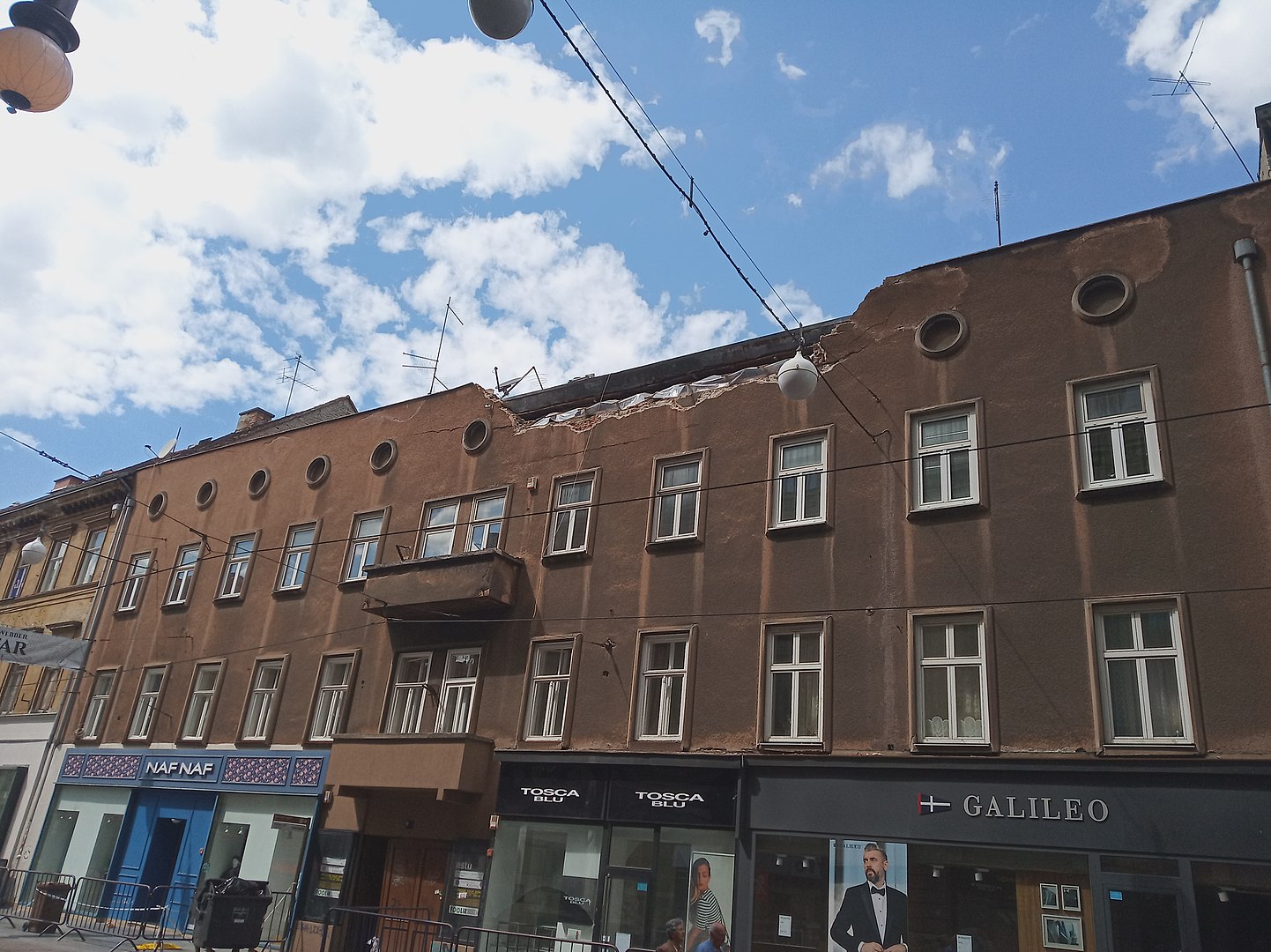
Damage to a dwelling on Ilica in central Zagreb © Franjo Tahy
The proposals are aimed at assisting the poorest homeowners affected, although the implications stretch much further
People who do not meet the low income/low asset criteria, who do not have a home insurance policy, must pay for 20% of their home renovation. Those who do have an insurance policy can request payment or partial payment of that 20% by their insurers.
It is possible that some unmarried couples who are living together, but not officially co-habiting, and whose income and assets exceed the set amount, could benefit before other couples who are married and legally co-habiting.
There are also potentially serious implications for those who are on a very low income, but who have inherited a property worth more than HRK 200,000 (approx €26,500).
In the final bill, there remains a provision for mortgaging real estate if the owners and co-owners cannot secure 20% of building renovation costs.
The new proposals also include the possibility of obtaining financial assistance for the repair of staircases in buildings, in addition to previously announced assistance for the repair of gable walls, elevators, chimneys, and the replacement of gas boilers.
Damage from the earthquake in Zagreb and surroundings was estimated at 86.4 billion kuna (approx €11.5 billion). The new proposals mean that a larger amount than this previous estimation will now be needed.
3.2 Magnitude Earthquake Shakes Central Croatia
Zagreb, August 23, 2020 – The EMSC reports that the epicentre of the earthquake was 66 kilometres south of Zagreb or 6 kilometres north-northwest of Velika Kladuša in Bosnia and Herzegovina.
Today, five months after two big earthquakes hit Zagreb, a new, but slightly weaker earthquake was recorded in Central Croatia at round 19:00 writes Večernji. Namely, the earthquake was recorded near the Croatian town of Slunj, and it was magnitude 3.2 on the Richter scale.
Citizens report that the earthquake was felt in Glina, Topusko, and Vrbovec.
Minor #earthquake (#zemljotres, #potres) shakes Croatia 19 min ago. Map of eyewitnesses' felt reports: pic.twitter.com/CwG6inDgNU
— EMSC (@LastQuake) August 23, 2020
Witnesses have written to the EMSC to state that they felt a slight tremor with the accompanying sound and that everything lasted for a few seconds.
Mirko Sardelic PhD: A Brief History of the Most Devastating Earthquakes
April 30, 2020 - Last month, Mirko Sardelic PhD gave an excellent interview for TCN - A History of Pandemics: Lessons to Apply to the Corona Crisis. Today, a brief history of the most devastating earthquakes.
Interviewer: Aco Momcilović, psychologist, EMBA, Owner of FutureHR
Interview with Mirko Sardelić, Ph.D., Research Associate at the Department of Historical Studies HAZU, Honorary Research Fellow of the ARC Centre of Excellence for the History of Emotions (Europe 1100-1800) at The University of Western Australia; formerly a visiting scholar at the universities of Cambridge, Paris (Sorbonne), Columbia, and Harvard.
In the aftermath of the Zagreb 2020 earthquake, many questions have arisen, and to answer some of them I again turned to history experts. It seems that earthquakes claimed millions of lives only in the last 100 years, and surprisingly unlike in many other areas, improvements in technology “have only slightly reduced the death toll”. They are dispersed around the world in critical areas, and they did force us to build in a smarter way. In the past, we attributed their causes to many different things, and today we have much clearer scientific information about their origins, yet, it seems they still make us feel helpless. How did our ancestors deal with all those questions? Hopefully, we will get some answers in my interview with Mirko Sardelić.
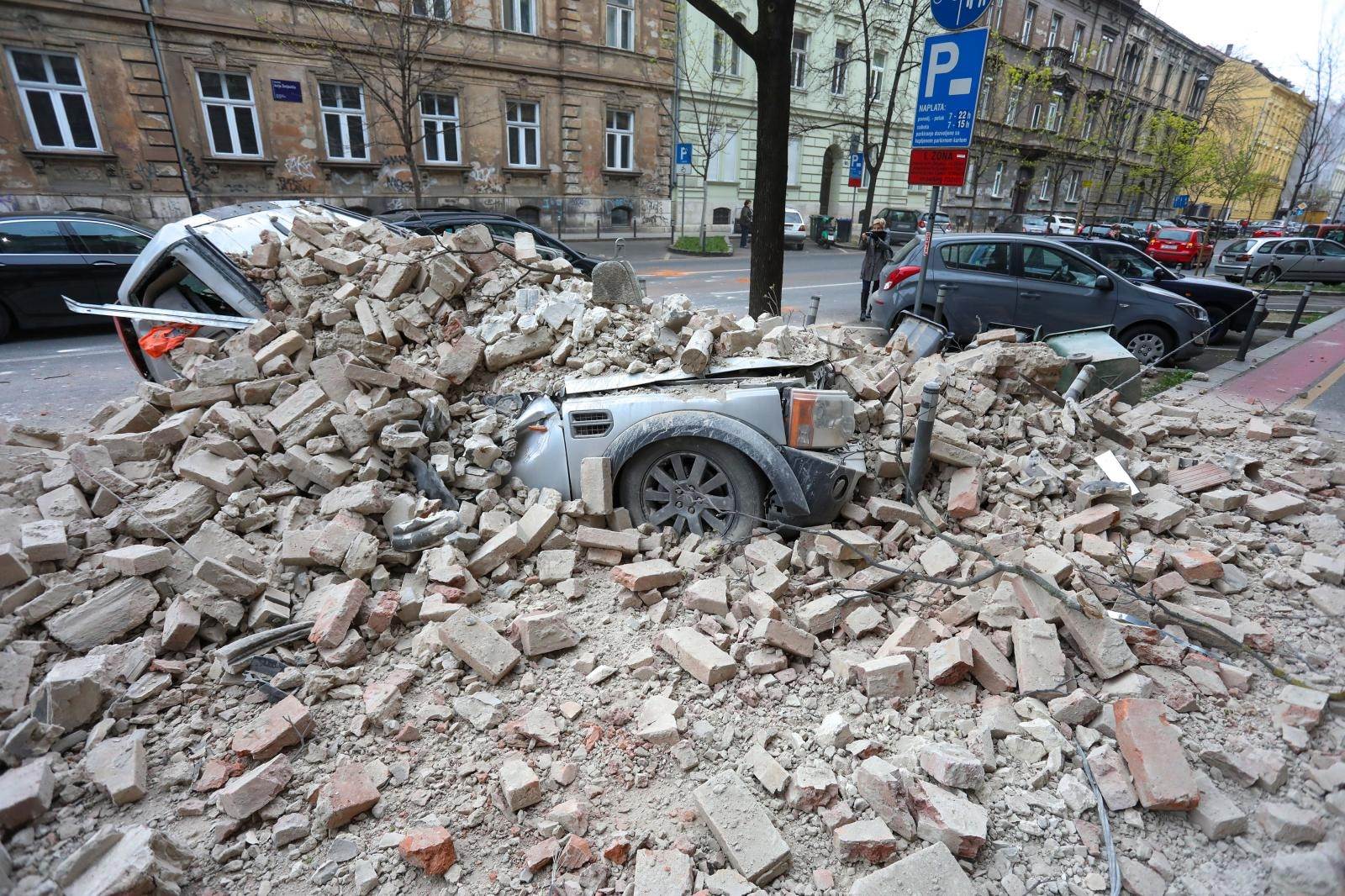
What were the strongest earthquakes in the Balkan region that history can remember?
When it comes to earthquakes, the most powerful ones, higher than 7 (even 8) of magnitude, were recorded in Greece, especially Crete. Greece also has the highest number of strong earthquakes in our region. It is enough to mention the Thera (the island of Santorini) earthquake of 1500 BC and eruption that changed the history of Minoan civilization. When compared to other world regions, it can be said that the Greek quakes are quite moderate in terms of human casualties, numbering hundreds, rarely thousands. In relatively recent history, when it comes to changing the way earthquakes were perceived in former Yugoslavia, the milestone was the Skopje earthquake (6.1 of magnitude, causing more than 1000 deaths) from the summer of 1963. It has lifted the construction standards in the region significantly. Quite destructive was the Montenegro earthquake of 1979 (over 7 in magnitude) which left its mark on the architecture of Montenegro, Albania, and South Croatia.
It needs to be mentioned here that in our vicinity Italy has the most horrifying history of earthquakes. The most devastating one was the 1908 Messina earthquake that killed almost 100.000 people, razing the cities of Messina and Reggio Calabria. In the Richter scale, it was 7.1 in magnitude, however, on the Mercalli intensity scale, it was the level XI (Extreme) of destruction. Most of these earthquakes happen along the ‘spine’ of the Italian Boot, and especially in the Tyrrhenian sea between the tip and Sicily. Every several years Italy experiences quake higher than 6.0 in magnitude, the most recent ones being the Umbria one in October 2016 (6.6 in magnitude) and the Lazio/Umbria quake in August 2016 (6.2 in magnitude).
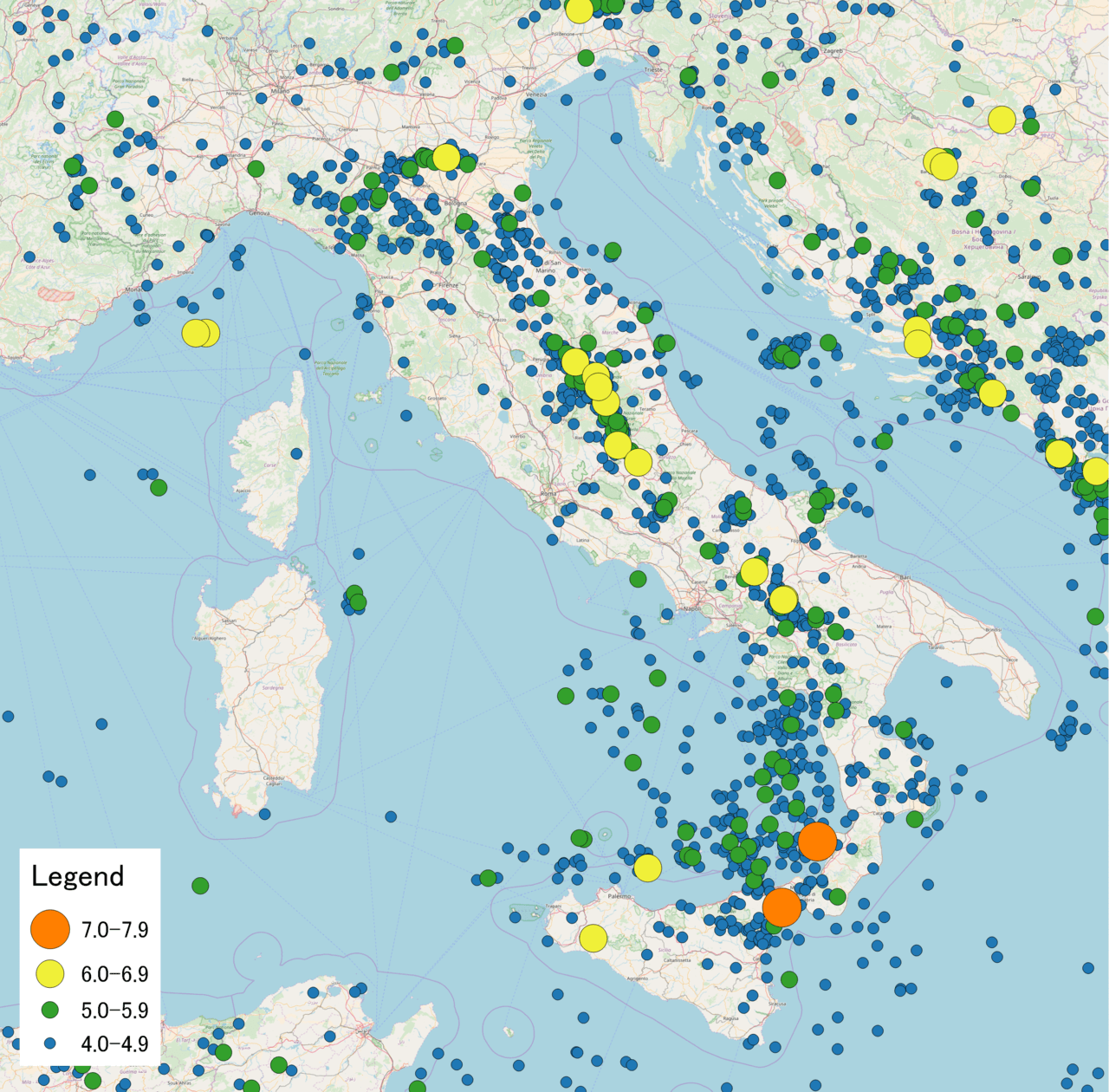
The Zagreb earthquake of 22 March 2020 was a 5.4 in magnitude on the Richter scale and VII (Very strong) on the Modified Mercalli intensity scale. Although the number alone (5.4) does not suggest terrible consequences, the hit wave had quite a strong impact on the historical city center. Late 19th century buildings didn’t handle the shock well and thousands of buildings in the heart of the city have been declared as inhabitable.
One of the two most terrible earthquakes in Croatian history was the Huge shake of 1667 that almost destroyed Dubrovnik. The city lies in the seismically most active part of Croatia and it is the most vulnerable in that aspect. The Quake was qualified as X (Very Strong) on the Mercalli scale. It killed more than 5.000 people and a big fire that raged for days followed. Also, the tsunami badly damaged the port and flooded parts of the city. The only two buildings that did not collapse were two palaces: The Sponza and the Rector Palace.
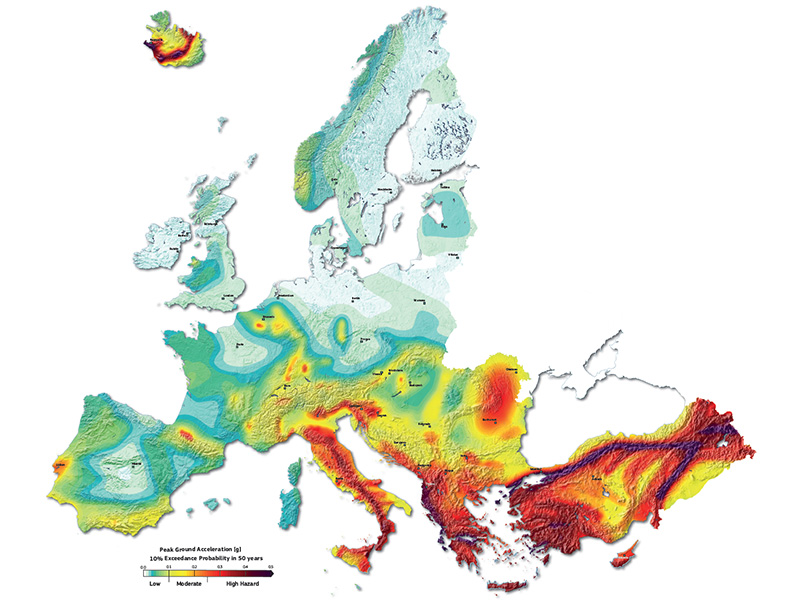
Several contemporary reports depict the horrifying situation just after the quake. One of these is the 20-canto epic Dubrovnik ponovljen (Dubrovnik rebuilt) by Jaketa Palmotić Dionorić, Dubrovnik envoy to Turkey, who lost his wife and four children to the earthquake. The letters of Frano Bobali offer a quite vivid and dramatic reconstruction of some events that followed. The Rector (mayor) of the city, alongside several governing officials, were killed, so the subsequent state of anarchy produced some nasty human-made trouble to town, such as shameless pillaging of both the rich and poor. This was, in fact, a whole package of sorrow, caused by both natural elements and humans. The fire and the dust from collapsing buildings made it a living hell for the inhabitants of the city who even thought of completely abandoning the place and establishing a brand-new town. Luckily, they had decided to stay and rebuild the city in a baroque fashion which has become world-famous for its beauty.
Do we have any data about the world’s most devastating earthquakes? How serious were their consequences, considering the number of people, and the differences in the complexity of architecture/engineering?
I am a big fan of desk globes. They are colorful, shiny, and give you an impression you understand the world. They mislead in another way: just by looking at them, one can not even imagine how fast the planet travels around the Sun (107.000 km/h) and rotates around its axis (1600 km/h). Beneath the surface there is no less action: tectonic plates collide, form trenches, layers break, magma fills the cracks; all those fuming and sizzling sounds, fortunately, remain unheard.
There are several scales that express the energy of the earthquake in numerical values – the most famous (albeit outdated) one being the Richter scale – developed upon the research made by Charles F. Richter and Beno Gutenberg. The numbers give quite precise ideas of how strong an earthquake is; nonetheless, the impact of each earthquake depends on several factors combined. The modern records show that the most powerful quake was a 9.5 magnitude earthquake in Chile (Valdivia) in 1960. The quake and the tsunami that followed killed some 6.000 people combined.

Some of the most horrible quakes – in terms of human victims – were recorded in Asia, which is the most vulnerable if we consider geology and population density factors combined. The Kanto earthquake in Japan (in 1923, magnitude 7.9) killed close to 150.000 people. A very powerful earthquake of Sumatra (in 2004, magnitude 9.1) killed 230.000 people and displaced close to 2 million people. The earthquake of Tangshan, China (in 1976, magnitude 7.5) killed more than 300.000 thousand people, making it one of the top three deadliest in human history. From the data, it is obvious that it is not all about the magnitude. Like the high body temperature, it indicates that there is a disturbance, but does not offer the full picture of the impact.
Since humans up until recently didn’t have the science to explain the causes of the earthquakes, to what forces were they attributed to? What are the most interesting fables created in connection with the earthquakes?
In Greek mythology, Zeus is arguably the omnipresent god, but when it comes to the earth and the sea most of the action was attributed to Poseidon, nicknamed the Earth-shaker. With his trident, he could provoke quakes that could destroy city walls, or just make the cliffs crack sufficiently enough to make a lovely spring appear in the landscape. Legend has it that when Nordic trickster god Loki starts trembling due to the snake venom that drops on his face, humans feel that as an earthquake. Traditional Japanese culture blamed the monster catfish named Namazu for causing their earthquakes by trembling. God named Kashima, therefore, holds the catfish down with a huge stone. (One of the possible explanations of the myth is that fish, like birds, can detect the tremor and subtle early signs of the incoming quake).

There are many animals involved in historical world depictions of different cultures. Animals’ movement, for one reason or another, is known to explain the origins of quakes. For example, in Hindu cosmology there are four elephants on the back of a turtle that stands on the snake and they all support the world. On the other hand, in East African legends, there is a giant fish that carries a cow on its back; the cow balances the Earth on its horns, and earthquakes happen when the cow occasionally moves the Earth from one horn to another, because of its aching neck. In the far Northeast, Siberian god Tuli carries the world on his dog-pulled sleds. When the dogs who have fleas stop to scratch, the Earth shakes.
In Maya mythology, gods destroyed the first two generations of people through a flood, and the third through the hurricane and the earthquake. On a related note, do you know that the Australian natives ‘sing the landscape’? – They connect their special places and journeys in song cycles. By singing and incorporating them into geocultural maps they can navigate their space like with the GPS: words of the song become locations of landmarks waterholes, changes in the landscape by elements and disasters. Aboriginal legends lead some Australian scholars to the locations where ancient earthquakes and meteor craters changed the landscape. Some African traditions connect earthquakes with the spirits of some famous leaders that have recently gone to the Underworld. The terrible sound of tremor is the iron gate closing or the spirit’s anger with some recent misbehavior of their people.
One of the most famous oracles in the ancient world, Pythia, resided at the Temple of Apollo at Delphi that was built directly on the fault line – a crack in the Earth’s crust. There were natural springs, and even more importantly, gas fumes from underground reservoirs. Some of these gases, such as methane and ethylene affected the priestesses putting them into a state of euphoria. This, alongside some other natural substances (such as laurel leaves), carried them into a state of trance that enabled communication with gods. In 373 BC the Temple was destroyed – by an earthquake, naturally – but it was rebuilt on the same spot. The ancient Greeks did not have anything against the tectonic activity, on the contrary. It provided them with several really important features: freshwater, hot water for baths, fertile pockets of land, terrain suitable for natural defense.
How did people deal with the damage they caused? Did any country/empire or ruler undertake some actions to help the victims?
The help for the victims of the Messina earthquake of 1908 was quite international. Russian, French, and English battleships and cruisers that joined the relief, as well as sailors of the US Great White Fleet, joined relief efforts. The high extent of the grave situation was evident in the measures imposed by Prime Minister Giovanni Giolitti. The martial law dictated that all looters (even if it had been just for food, to survive) were to be shot.
There are differences in the response towards hardening structures after the quakes. Italy has been hit by dozens of quite strong earthquakes in the last fifty years. Still, the majority of the renovated buildings, unfortunately, does not comply with anti-earthquake standards. This can be analyzed from several angles, including the profile and age of Italian traditional architecture. Infrastructure approaches and the cultural heritage protection standards are somewhat different than, for example, in Japan, a country which is proverbially shaken quite often. Furthermore, the anti-seismic regulation in Italy dates from the 1970s, while the same regulation in Japan started in the 1920s.
The Great Hanshin earthquake, known also as the Kobe quake of 1995, saw some quite positive aspects of responding to the second-worst earthquake in Japan in the 20th century. Firstly, there were more than a million volunteers helping the relief efforts in the first 90 days following the disaster. There were more than 120,000 structures that fully or partially collapsed – it took three full years to completely remove the debris. Secondly, a relatively poor response to the catastrophe on the national level was significantly improved; for instance, the government can hold the emergency meeting of its crisis management team in 30 minutes nowadays. Some other urban, political, and social measures were taken, and one can expect a quite better response in the future. Nonetheless, the merciless chthonic strength that in 1995 ashamed Japanese engineers, arguably the world’s finest still poses questions that pend over the heads of the government.
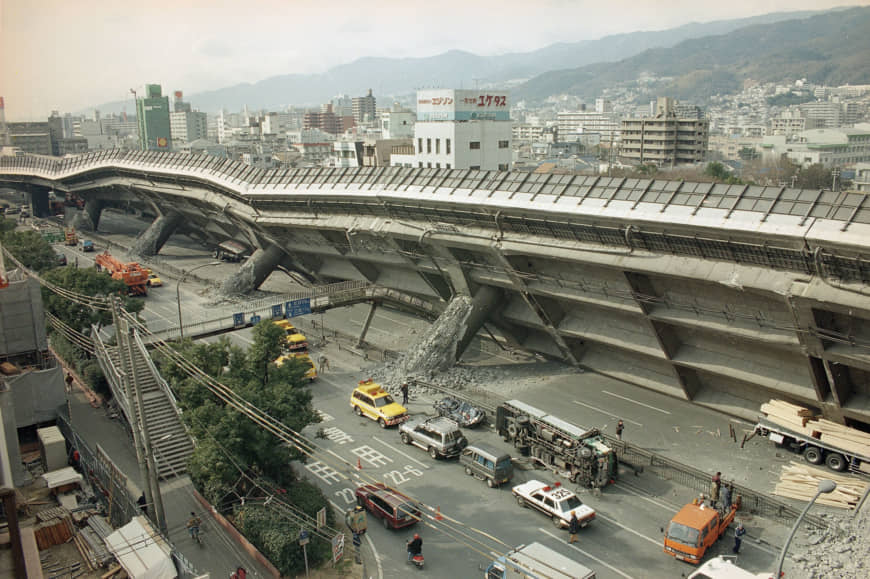
Did laws adapt to the possibility of earthquakes, and when did people start to think about the insurance?
Earthquake insurance is a quite complex issue, so governments and insurance companies deal with it in different ways. The complexity lies in the nature of this disaster – it strikes almost indiscriminately all structures in a particular area. On top of that – which is a problem for both homeowners and insurance companies – the quakes are very often accompanied by other elements, such as fires and floods, largely due to problems with gas or water pipes. Unfortunately for everyone, the earthquake rarely comes alone, but rather with some several nasty companions.
In Turkey, for example, earthquake insurance is compulsory. In Japan, there is an Earthquake Reinsurance scheme (started in 1966 and revised several times) through which the government helps the insurers with billions of US dollars (up to $ 40 billion in a single year). In the US not many people buy earthquake insurance, even fewer in Italy where less than 1% of homeowners are insured for earthquakes. Italy has quite an unpleasant tradition of being uninsured for natural disasters. Attempts to introduce it failed for two main reasons: the costs involved and the difficulties in assessing the risk.
Is there a difference in the cultures that differently approach the explanation of earthquakes?
As I mentioned in our previous interview, there are cultural variations in ways how people experience and express emotions. Nevertheless, some constants have been described across cultures. For example, when it comes to disgust, members of all cultures react to the following: bodily excretions (feces, vomit, blood); something rotten, diseased or dying; filthy places; sexual intercourse with the members of one’s family; heavy injuries. Disgust protects us from pathogens and other harmful influences.
Similarly, fear protects us from dangers. There are so many noted phobias, such as acrophobia (fear of heights) or pyrophobia (fear of fire), but they all could be categorized in just several groups, shared by all cultures. The ultimate fear that can provoke terrible anxieties is of existential nature or simplified: the fear of death, of no longer being. Secondly, there is a fear that something will happen to our body, that we’ll lose a limb, or it will be invaded by a foreign matter/agent; this provokes the fear of snakes, insects, bacteria. The third fear relates to the loss of autonomy: that we’ll get trapped, immobilized, confined (claustrophobia in all forms). The fourth is the fear of loss, abandonment, rejection; while the fifth is the fear of ego-death – i.e. the collapse of our constructed sense of all the elements (often not palpable) that make us the persons we are.
In this sense, it is obvious that there are elements of several fear categories connected to earthquakes (seismophobia). Humans fear for their life, there are serious threats that the falling debris will provoke injuries to their bodies, or trap them beneath the rubble. This might be an explanation of why we all feel a state of shock after a serious earthquake, and why people may display questionable behavior just after the disaster. A cocktail of very unpleasant emotions leaves traumas on everyone.
Do we have earthquakes mentioned in literature or other forms of art?
From the Greco-Roman traditions, I can remember only short but powerful references to all sorts of ‘shakings’ attributed to gods and their activity. The London earthquake of 1580 was so powerful that it found a reference in, among other literary works, Shakespeare’s Romeo and Juliet. The Nurse (Act 1, scene 3) takes it as a milestone, dividing the time before and after: “Tis since the earthquake now eleven years”. Gentleman Arthur Golding, who famously translated Ovid’s Metamorphoses, the work that inspired Shakespeare and so many others, wrote a Discourse upon the earthquake, just one of three of his original writings.
Approximately once every 200 years, a powerful earthquake wreaks havoc on Lisbon, Portugal. After terrible shakes of 1321 and 1531, the 1755 earthquake (one of the most destructive in history) was well documented in visual depictions and documents. This earthquake is also important because of the questionnaire created by the famous Portugal statesman Marquis of Pombal. This document was sent to all parishes of the country, asking information about the direction in which buildings collapsed, the change in the sea level, fires, and some quite intelligent details which were very useful for scholars to reconstruct the nature of the earthquake and the extent of the damage. This was indeed the first attempt to describe an earthquake with a scientific method and the Marquis was considered a proto-seismologist.
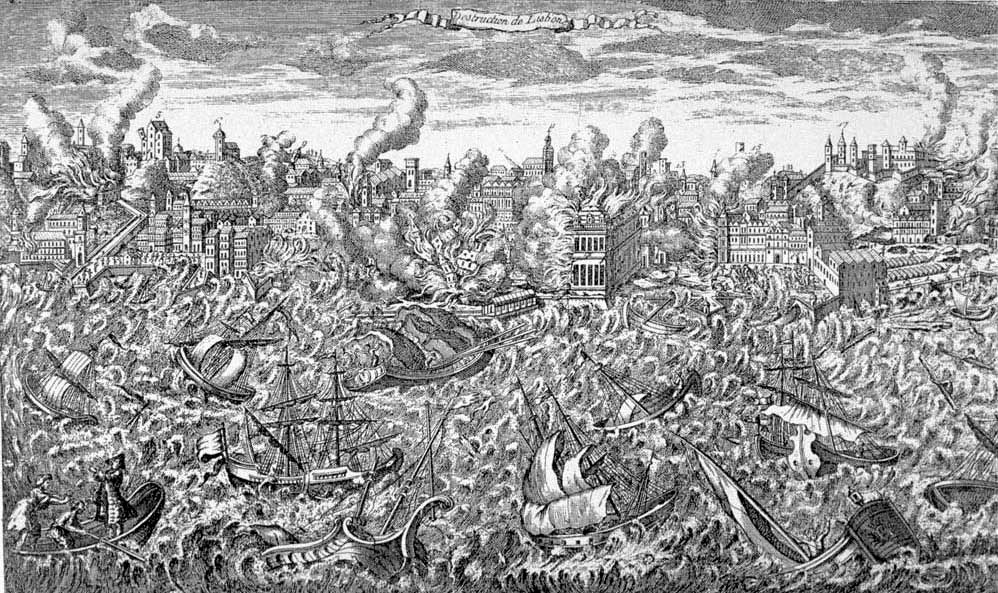
There is a quite impressive collection of 19th-century Japanese woodblock prints that allegorically depict earthquakes and the abovementioned giant fish Namazu who causes them. One can clearly contrast those with realistic images of late 18th-century paintings and engravings of the Portugal earthquake. In the collection related to the Great Nobi quake of 1891 one notices some elements of a cross-cultural ‘tension’. Namely, one of the favorite motifs of Japanese artists was the destruction of Western imports, such as railroads, telegraph wires, and brick buildings in earthquakes. Japan opened to the West in 1853 and many of these features of contemporary engineering and technologies were brought to Japan. They were regarded as supreme until nature challenged these achievements of civil engineering.
In more recent history, I read about Christina McPhee and Susan Norrie, artists who created a video and digital representations of quakes associated with memory and emotional response such as fear, traumas, and anxieties. They explored correlations between seismic activity and the human mind, the triggers, and reactivations of traumatic memories. Performance artists can quite interestingly represent and interpret the intertwining of all these phenomena such as the tremendous activity and the power of nature, the fragility of humans, and all the triggered psychological states – the immediate and those lingering for weeks, months, years.
When it starts shaking, there are a lot of these seismic waves that truly play with our bodies and minds, in various ways. The energy unleashed by the most powerful earthquakes is sometimes beyond imagination, it could power whole countries for months. An earthquake was recorded that slightly changed the rotation of our planet. More probable ones, those in the magnitude of 6.0, have the energy of a nuclear bomb. There are earthquake simulators – at the Natural history museum in London, for example – that can give some ideas of how terrifying they can be. Hopefully, that will be as close as you will ever get to experience one of these devastating quakes.
Two Earthquakes Wake Šibenik Locals
A rude awakening during the early hours in the morning for some.
Earthquakes: Dalmatia Among Most Threatened Areas in Croatia
Dubrovnik was almost wiped off the map during the 1600's, but just how prepared is Dalmatia for a potentially devastating earthquake in the modern day? Not very, it would seem.


